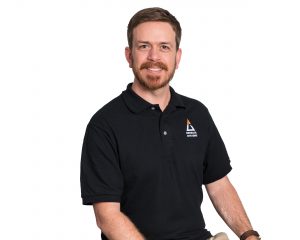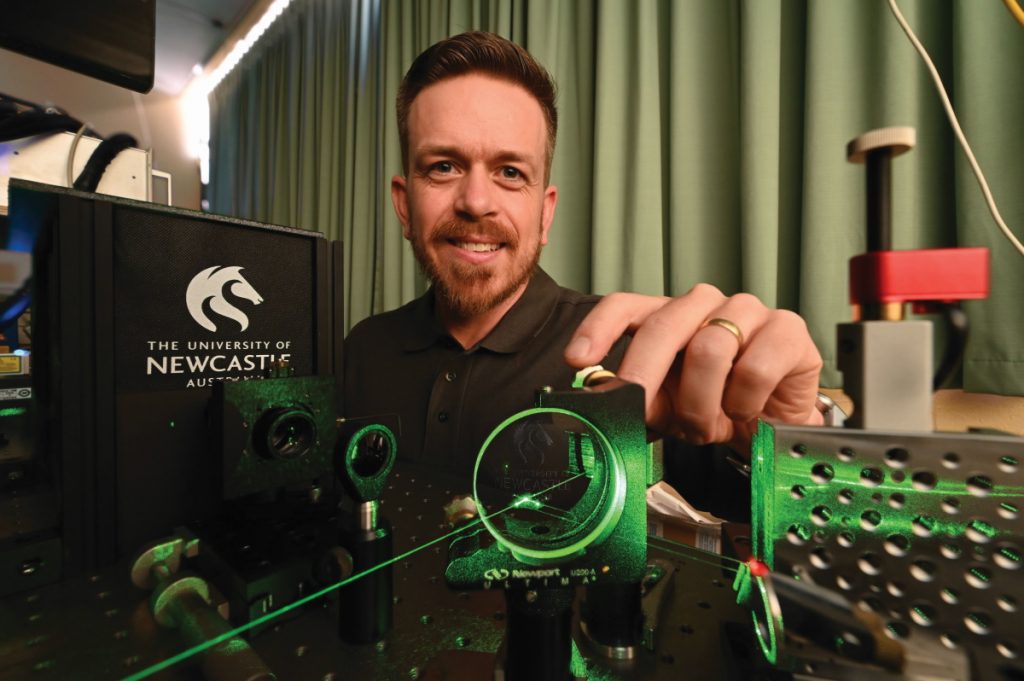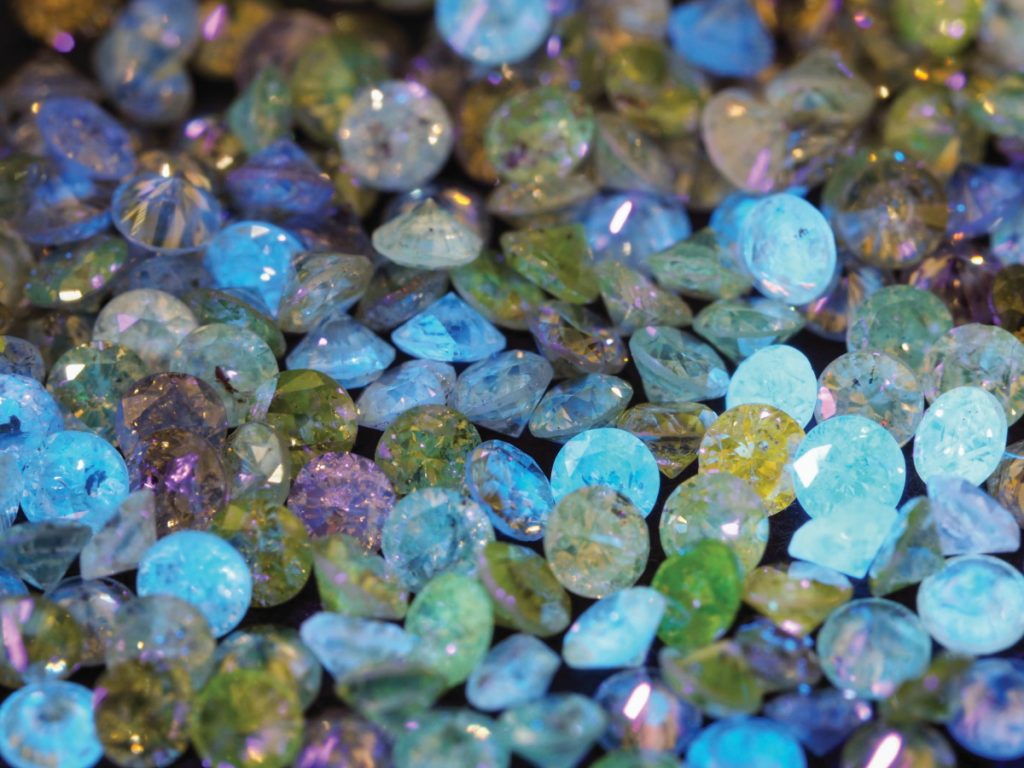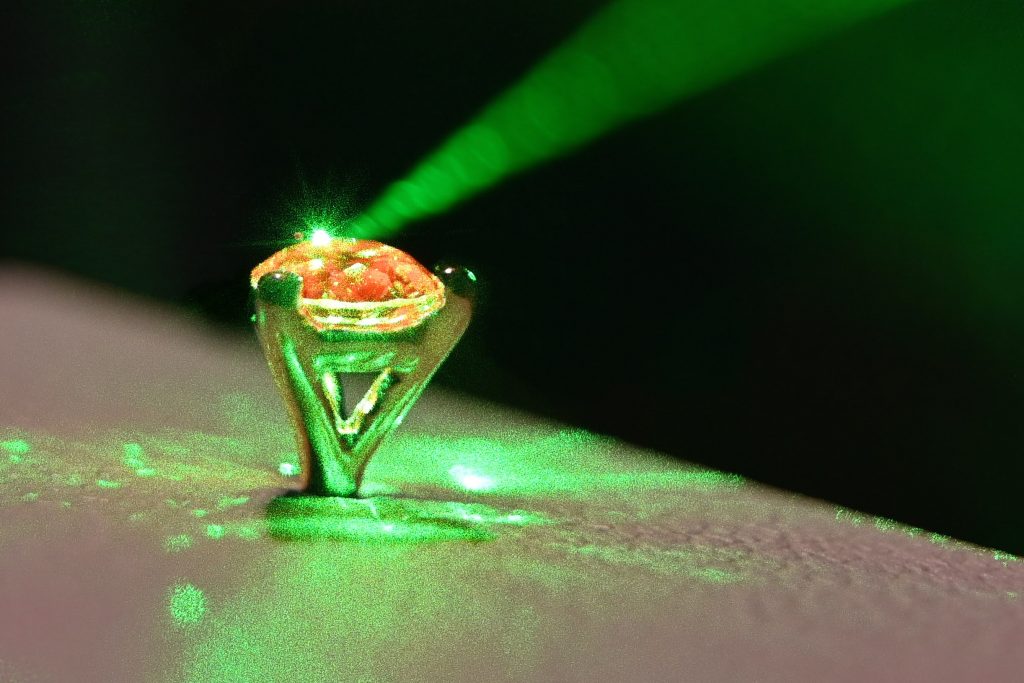Glowing diamonds are a quantum scientist’s best friend
Dr Lachlan Rogers, based at the University of Newcastle in Australia, is investigating diamond colour centres. The ultimate aim is to enable the development of new quantum technologies that will revolutionise many aspects of life
Diamonds are precious stones that were formed on Earth more than one billion years ago. They are the hardest natural substance on our planet and are made of only one element: carbon. When we think of diamonds, we probably imagine a white, silvery shining jewel, but the truth is that diamonds can come in pretty much any colour. They are formed deep within the Earth’s crust when intense pressure and heat cause carbon atoms to crystallise. It is believed that because of similar conditions deep within Neptune and Uranus, it rains diamonds – imagine the umbrella you would need if you ever found yourself walking around on either planet!
As scientific research continues to discover new and improved ways of doing things, technological developments enable scientists to perform tasks and experiments that would have been unimaginable just a few decades ago. For instance, it is now possible to grow diamonds in a laboratory, simply by reproducing the geological conditions needed (heat, pressure and carbon). But, you might ask, why are scientists interested in growing diamonds? Well, it is not because they want to become exceedingly rich – the diamonds that are grown for Lachlan’s lab are only about four nanometres in size (about 100 times smaller than the wavelength of visible light) even though it is possible to grow larger diamond samples. These diamonds are of interest to researchers because they enable experiments relating to quantum physics.
Dr Lachlan Rogers, based at the University of Newcastle in Australia, is investigating diamond colour centres. Colour centres are defects where a non-carbon atom interrupts the regular array of atoms within the diamond, and they absorb some visible and ultraviolet light. “They are what give some diamonds ‘colour’ and the ‘centre’ refers to the fact they are just an atom or two in size – about as small as it gets in a crystal!” says Lachlan. He and his team are using diamonds grown in a lab rather than naturally occurring diamonds. This is because even the best naturally occurring diamonds have too many atomic defects. Lab-grown diamonds have an extremely high chemical purity, allowing control of the colour centres that form. It is these colour centres that open up an exciting world of quantum technology applications.
WHY ARE COLOUR CENTRES IMPORTANT TO LACHLAN’S RESEARCH?
It is worth noting that it is only the colour centres of diamonds that interact with and absorb/emit visible photons – bundles of electromagnetic energy that makes up all light. The pure diamond crystal surrounding these centres is transparent to visible light and is essentially useless when it comes to experiments in quantum physics. “A single colour centre can emit a clearly detectable amount of light, so we can ‘talk’ to just one at a time,” says Lachlan. “However, there is a limit on how small you can focus light, so even with the best lenses, there are tens of thousands of atoms in the optical ‘detection spot’. To be able to talk to just one colour centre we need to know that the typical distance between colour centres in the diamond is much more than this focus size.” Lachlan’s aim is to have just a few colour centres per billion carbon atoms in the diamond crystal.
HOW DOES THE TEAM HARNESS COLOUR CENTRES TO BUILD QUANTUM COMPUTERS?
Lachlan and the team are looking at the light that comes from a single colour centre, which essentially means they are ‘talking’ to a single electron. Diamonds are a vehicle, providing a convenient way to hold that single electron in place. “Electrons have physical properties like mass and energy, but they also have a quantum property known as ‘spin’,” says Lachlan. “This ‘spin’ can be used to store and process quantum information.”
WHAT IS QUANTUM METROLOGY?
In addition to shining a light on the possibilities surrounding quantum computing and a quantum internet, the team’s investigations consider how colour centres feed into quantum metrology – which makes use of quantum details to improve measurement precision and sensitivity. Two notable examples of this at work are the atomic clock, which is the most accurate means of determining the time and is based on the interaction of electromagnetic radiation with the excited states of atoms; and Magnetic Resonance Imaging (MRI), which is used in hospitals to look inside a patient’s body.
Recently, it has become possible for Lachlan and other researchers to control and interact with single quantum objects at a time. “A single colour centre in diamond can do the same measurements as an MRI machine, but on a single molecule in a biological cell,” explains Lachlan. “By giving us access to single quantum objects, diamond colour centres are enabling quantum measurement of magnetic fields, electric fields and temperature.”
WHAT IS LACHLAN’S ULTIMATE GOAL?
As you might already know, quantum physics appears to have magic capabilities that cannot be explained by classical physics (hence the rise of a sister branch of physics). Lachlan’s work is focused on harnessing capabilities that could give rise to a quantum internet which, in theory, would be able to perform tasks that are simply not possible using the internet of today. Then there is the field of quantum sensors, which would revolutionise molecular bioscience and improve treatments, therapies and the lives of people around the world.
Experiments in these fields are extremely difficult, but diamond colour centres provide a means of helping such technologies work at room temperature instead of inside massive super-fridges. Lachlan’s aim is to discover and engineer diamond colour centres that have better quantum properties and could help to revolutionise our world.
Reference
https://doi.org/10.33424/FUTURUM133
Diamonds are precious stones that were formed on Earth more than one billion years ago. They are the hardest natural substance on our planet and are made of only one element: carbon. When we think of diamonds, we probably imagine a white, silvery shining jewel, but the truth is that diamonds can come in pretty much any colour. They are formed deep within the Earth’s crust when intense pressure and heat cause carbon atoms to crystallise. It is believed that because of similar conditions deep within Neptune and Uranus, it rains diamonds – imagine the umbrella you would need if you ever found yourself walking around on either planet!
As scientific research continues to discover new and improved ways of doing things, technological developments enable scientists to perform tasks and experiments that would have been unimaginable just a few decades ago. For instance, it is now possible to grow diamonds in a laboratory, simply by reproducing the geological conditions needed (heat, pressure and carbon). But, you might ask, why are scientists interested in growing diamonds? Well, it is not because they want to become exceedingly rich – the diamonds that are grown for Lachlan’s lab are only about four nanometres in size (about 100 times smaller than the wavelength of visible light) even though it is possible to grow larger diamond samples. These diamonds are of interest to researchers because they enable experiments relating to quantum physics.
Dr Lachlan Rogers, based at the University of Newcastle in Australia, is investigating diamond colour centres. Colour centres are defects where a non-carbon atom interrupts the regular array of atoms within the diamond, and they absorb some visible and ultraviolet light. “They are what give some diamonds ‘colour’ and the ‘centre’ refers to the fact they are just an atom or two in size – about as small as it gets in a crystal!” says Lachlan. He and his team are using diamonds grown in a lab rather than naturally occurring diamonds. This is because even the best naturally occurring diamonds have too many atomic defects. Lab-grown diamonds have an extremely high chemical purity, allowing control of the colour centres that form. It is these colour centres that open up an exciting world of quantum technology applications.
WHY ARE COLOUR CENTRES IMPORTANT TO LACHLAN’S RESEARCH?
It is worth noting that it is only the colour centres of diamonds that interact with and absorb/emit visible photons – bundles of electromagnetic energy that makes up all light. The pure diamond crystal surrounding these centres is transparent to visible light and is essentially useless when it comes to experiments in quantum physics. “A single colour centre can emit a clearly detectable amount of light, so we can ‘talk’ to just one at a time,” says Lachlan. “However, there is a limit on how small you can focus light, so even with the best lenses, there are tens of thousands of atoms in the optical ‘detection spot’. To be able to talk to just one colour centre we need to know that the typical distance between colour centres in the diamond is much more than this focus size.” Lachlan’s aim is to have just a few colour centres per billion carbon atoms in the diamond crystal.
HOW DOES THE TEAM HARNESS COLOUR CENTRES TO BUILD QUANTUM COMPUTERS?
Lachlan and the team are looking at the light that comes from a single colour centre, which essentially means they are ‘talking’ to a single electron. Diamonds are a vehicle, providing a convenient way to hold that single electron in place. “Electrons have physical properties like mass and energy, but they also have a quantum property known as ‘spin’,” says Lachlan. “This ‘spin’ can be used to store and process quantum information.”
WHAT IS QUANTUM METROLOGY?
In addition to shining a light on the possibilities surrounding quantum computing and a quantum internet, the team’s investigations consider how colour centres feed into quantum metrology – which makes use of quantum details to improve measurement precision and sensitivity. Two notable examples of this at work are the atomic clock, which is the most accurate means of determining the time and is based on the interaction of electromagnetic radiation with the excited states of atoms; and Magnetic Resonance Imaging (MRI), which is used in hospitals to look inside a patient’s body.
Recently, it has become possible for Lachlan and other researchers to control and interact with single quantum objects at a time. “A single colour centre in diamond can do the same measurements as an MRI machine, but on a single molecule in a biological cell,” explains Lachlan. “By giving us access to single quantum objects, diamond colour centres are enabling quantum measurement of magnetic fields, electric fields and temperature.”
WHAT IS LACHLAN’S ULTIMATE GOAL?
As you might already know, quantum physics appears to have magic capabilities that cannot be explained by classical physics (hence the rise of a sister branch of physics). Lachlan’s work is focused on harnessing capabilities that could give rise to a quantum internet which, in theory, would be able to perform tasks that are simply not possible using the internet of today. Then there is the field of quantum sensors, which would revolutionise molecular bioscience and improve treatments, therapies and the lives of people around the world.
Experiments in these fields are extremely difficult, but diamond colour centres provide a means of helping such technologies work at room temperature instead of inside massive super-fridges. Lachlan’s aim is to discover and engineer diamond colour centres that have better quantum properties and could help to revolutionise our world.
 DR LACHLAN ROGERS
DR LACHLAN ROGERS
Lecturer, School of Mathematical and Physical Sciences
The University of Newcastle, Australia
FIELD OF RESEARCH: Quantum Optics
RESEARCH PROJECT: Lachlan works on a project that focuses on diamond colour centres. They are one of the most promising means of enabling the development of various quantum technologies that will change the world.
FUNDERS: Australian Research Council Centre of Excellence for Engineered Quantum Systems (EQUS)
 DR LACHLAN ROGERS
DR LACHLAN ROGERS
Lecturer, School of Mathematical and Physical Sciences
The University of Newcastle, Australia
FIELD OF RESEARCH: Quantum Optics
RESEARCH PROJECT: Lachlan works on a project that focuses on diamond colour centres. They are one of the most promising means of enabling the development of various quantum technologies that will change the world.
FUNDERS: Australian Research Council Centre of Excellence for Engineered Quantum Systems (EQUS)
ABOUT QUANTUM OPTICS
Put simply, quantum optics is the study of how photons interact with atoms and molecules. Scientists like Lachlan are working on accurately controlling these interactions and creating quantum states of matter and light that can facilitate the development of a wide range of quantum technological applications. The research and experiments that Lachlan is conducting could help us create a quantum computer and develop sensors made from individual atoms. It is difficult to overstate how much this would change the world as we know it.
You might remember an article in Futurum Careers that centred on the work of Dr Thomas Volz – his concerns were very similar to those of Lachlan. But, interestingly, Lachlan actually worked in Thomas’s lab in the past and is a co-founder of Redback Systems, a company created by Thomas and Lachlan. Clearly, quantum optics is an exciting and emerging field of science that will afford any student a range of opportunities and directions in which to move forward in their career.
WOULD LACHLAN RECOMMEND A CAREER IN QUANTUM OPTICS?
Absolutely! One of the most exciting aspects of quantum physics is that it is weird and magical, and flies in the face of many things we consider intuitive. That keeps it interesting and will always throw up fascinating surprises. “It is a fantastic time to consider a career in quantum science, because so many new options are opening up. Once upon a time electromagnetism was a fundamental research field in university laboratories, but it is now normal to study electrical engineering because so many commercial and industrial tools rely on electronics,” says Lachlan. “The same is happening right now for quantum technologies – we are on the cusp of the first-ever generation of quantum engineers.”
HOW BIG IS THE FIELD OF QUANTUM OPTICS IN AUSTRALIA?
As Lachlan and Thomas have shown, there is clearly loads of interest in quantum physics and quantum optics down under. It is a large and active field in Australia and, like many countries, researchers have developed a strong research focus on quantum science and its wide range of applications. “Not all quantum technologies are optical (others use electronic control and readout), but optical control has some advantages because it does not require physical contact,” explains Lachlan. “At a meeting two years ago of just the people in Australia working on quantum technologies in diamond, there were at least 100 people –and many more work on other related quantum optical systems.”
WHAT DOES THE FUTURE HOLD FOR QUANTUM OPTICS?
As mentioned, we should perhaps think about what the future holds for humanity with the development of quantum optics! We are all familiar with computers and digital communications, which are electronic devices that enable us to perform an enormous range of tasks. But all of these technologies are based on the principles of classical physics – quantum optical technologies will run much faster. If you have broadband in your home, ask your parents if you have optical fibre internet – that has significantly sped up the speed at which you can connect to the internet; there is a similar potential for optical computers, even if they are not quantum computers.
• Nature Research has an entire section of its website dedicated to quantum optics, featuring loads of open access research papers. Some of them will be very challenging to understand, but the abstracts should give you an idea of what is happening in the field.
• The Optical Society is a brilliant resource for those interested in understanding more about optics and photonics.
• The world of physics is changing and becoming more inclusive than it has historically been. Lachlan’s position at the University of Newcastle is part of generational handover, where many professors have recently retired and been replaced by younger academics. The physics department there is 50% male and 50% female, which shows that the field is heading in the right direction. Work hard and you have a great chance of success!
PATHWAY FROM SCHOOL TO QUANTUM OPTICS
An understanding of maths and physics is a basic requirement for studying quantum optics, but do try and focus on other subjects that may come in handy, such as English (for writing theses, papers and presentations), and IT, which will help give you a greater understanding of computing.
You will need a degree in a relevant subject for postgraduate study.
https://www.prospects.ac.uk/careersadvice/what-can-i-do-with-my-degree/physics
HOW DID LACHLAN BECOME INVOLVED IN QUANTUM OPTICS?
DID YOU ALWAYS KNOW YOU WANTED TO BE A SCIENTIST?
I don’t remember specifically wanting to be a scientist, but I have always found science and mathematics very interesting. When I was young, my dad would play games with me when slicing apples: “Would you like ONE third or TWO eighths?” and I had to work out which one gave me more apple!
WHO OR WHAT INSPIRED YOU TO STUDY MATHS AND PHYSICS?
My dad and (maternal) grandfather both have science PhDs, so an interest in maths and physics certainly seemed ‘normal’ to me as a child. At various times I visited universities for holiday programmes and public lectures, and I was enthralled by all the amazing instruments and lab devices. I think part of my interest in physics is just that I like playing with cool toys!
HOW DID YOU END UP GETTING INTO QUANTUM OPTICS AND THE INVESTIGATION OF COLOUR CENTRES IN DIAMONDS?
When I was an undergraduate student, I applied for a student travel scholarship to attend the Australian Institute of Physics Congress. The form had a field for areas of interest and I wrote quantum computing because it sounded cool to me. A professor saw this form and offered me a tour of their research lab, and I was so excited by the things I saw that I ended up doing my PhD under that professor!
EARLIER ON IN YOUR CAREER YOU WERE SUPERVISED BY DR THOMAS VOLZ. HOW DID YOU COME TO WORK WITH THOMAS AND WHAT DID YOU LEARN?
After my PhD I moved to Germany to do postdoctoral research for a few years. I was successful in applying for an early-career research fellowship in Australia and came back to work with Thomas. I learned loads of things – but the main scientific tasks I worked on were temperature sensing and optical cavities (light bouncing back and forward between two mirrors). We were trying to make a diamond-powered laser to measure tiny magnetic fields.
YOU HAVE SINCE COME TO HAVE YOUR OWN RESEARCH GROUP. WHY DID YOU SET THIS UP AND IS IT A TYPICAL CAREER PATH FOR RESEARCHERS?
The research fellowship that I had working in Thomas’s lab was a fixed-term, not ongoing. This is very normal for early-career academic research. I applied for numerous positions over a few years and was delighted to be offered an ongoing job at the University of Newcastle. This is geographically close enough to keep close collaborations with Thomas and other colleagues in the Sydney area. Getting an ongoing position (a ‘proper job’ as I often joke with friends) is a huge step on the career path for researchers. It means my research is interrupted more by having to teach (luckily, I enjoy teaching), but it also means that I can make longer-term research plans and really work towards big goals and projects.
LACHLAN’S TOP TIPS
01 If you want to get into quantum optics you can never do too much maths! It is very much the language of physics, so improving your mathematical fluency will always serve you well throughout your studies and later career.
02 Being able to write software has turned out to be a bit of a ‘superpower’ in my research career! I am lucky that it was an amateur interest of mine throughout school. If you have the opportunity to study some coding or software design, you should take it – I am sure it will benefit your interest in quantum physics.
03 The field of quantum optics (and quantum physics, in general) is developing at an increasingly fast rate. It is important to try and keep on top of the latest developments, so do your best to read science magazines and trawl through science websites. There are also loads of high-quality YouTube videos explaining scientific concepts, which can help.
Write it in the comments box below and Lachlan will get back to you. (Remember, researchers are very busy people, so you may have to wait a few days.)









G’day Lachlan! Great to read about what you are up to these days, congratulations on your success!